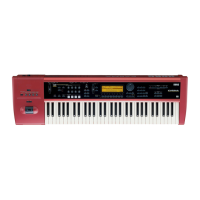100
Insert effects
Here you can select the effects for each IFX1–IFX5,
adjust the “Pan (CC#8)” setting that follows each insert
effect, and specify “BUS Select,” “S1 (Send1(MFX1)),”
and “S2 (Send2(MFX2)).” If insert effects are connected
in series, the setting after the last IFX will be valid. Use
“S1 (Send1(MFX1))” and “S2 (Send2(MFX2))” to adjust
the depth of the master effects after the signal has
passed through the IFX. These settings are made in the
same way as for programs (☞p.90).
Master effects
Master EQ
These settings are made in the same way as for pro-
grams (☞p.98).
About dynamic modulation
(Dmod)
Dynamic modulation (Dmod) is a function that lets
you use MIDI messages or this instrument’s controllers
to control specific effect parameters in realtime.
BPM/MIDI Sync is another function that controls effect
parameters, and is used to synchronize the LFO speed
of modulation-type effects or the delay time etc. of
delay-type effects to the tempo of the KARMA function
or an external sequencer.
For details on each of these functions, refer to PG p.227.
Setting example:
We will show how you can use dynamic modulation to
control an effect parameter in realtime.
1 As described in the procedure for “Effect settings
for a program” (☞p.98), set “IFX1” to 049: LCR
BPM Delay. Verify that a delay sound is being out-
put.
2 Select the PROG 7.1: Ed-Insert FX, IFX1 page.
Using the Dmod function to vary the delay level by
pushing the joystick away from yourself
3 Set “InLvl Mod” to +100.
4 Set “Src” to JS+Y#1.
The joystick will control the input level to the effect.
When you set “Src” to JS+Y#1, the delay sound will
no longer be output; however it will gradually
increase as you move the joystick away from your-
self.
Using the Dmod function to vary the feedback
level by operating” [SW1] key
5 In the PROG 2.2: Ed-Ctrl, Controls page, set the
function of [SW1] key to SW1 Mod. (CC#80), Tog-
gle.
6 Return to the PROG 7.1: Ed-Insert FX, IFX1 page,
and set the C Fb (C Delay Feedback) “(Source)” to
SW1 #80.
7 Set “(Amount)” to +30.
8 When you (move the joystick away from yourself
and) press the [SW1] key, the feedback level will
increase, and the delay sound will continue repeat-
ing more times.
The “(Amount)” setting determines the feedback
level when the [SW1] key is pressed. If you set
“(Amount)” to –10 and press the [SW1] key, the
feedback level will be 0.
Using the BPM/MIDI Sync. function to modify the
delay time in synchronization with tempo changes
of the KARMA function
9 Set “BPM” to MIDI.
0 For L, C, and R, set “L/C/R Bs” and “Times” as
desired.
For this example, set “L/C/R Bs” to and “Times”
to 1 so that the effect will be easily understandable.
The delay time will repeat at an interval of a 8th
note.
A Turn the [TEMPO] knob.
When you (move the joystick away from yourself
and) rotate the knob, the delay time will change.
B Turn on the KARMA [ON/OFF] key and begin
playing.
(Move the joystick away from yourself and) select
the pattern that you want KARMA to play.
When you turn the [TEMPO] knob, the delay time
will change in synchronization with the change in
KARMA playback tempo.
If you rotate the [TEMPO] knob to change the
tempo while the delay is sounding, noise may
occur in the delay sound. This is because the delay
sound becomes discontinuous, and is not a mal-
function.
For some effects, you can synchronize the LFO fre-
quency to the tempo. Set the effect parameters
“BPM/MIDI Sync” to On, and “BPM” to MIDI.
For details refer to PG p.173.

